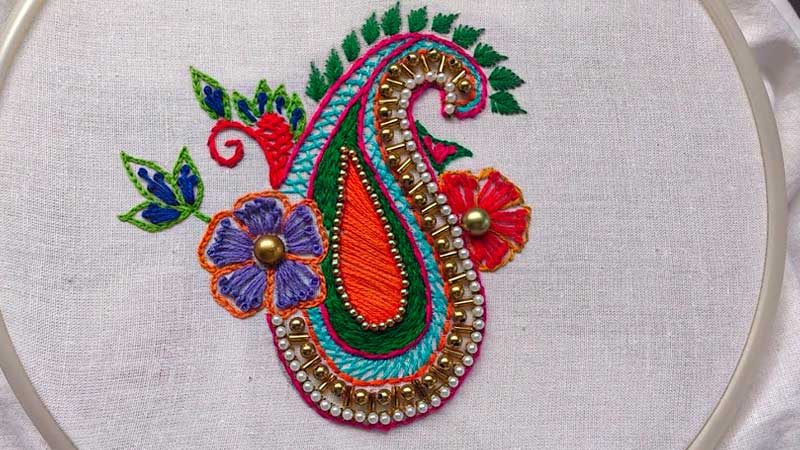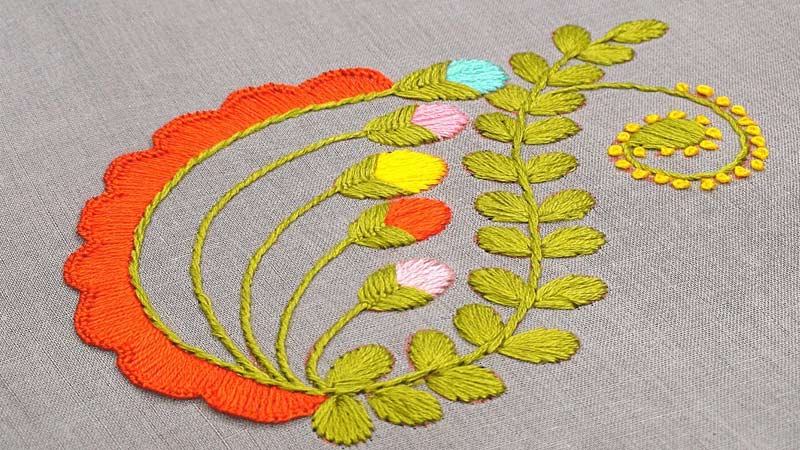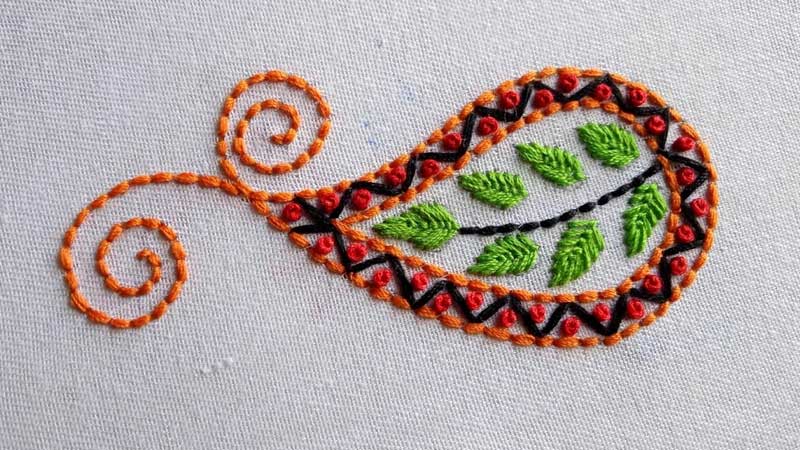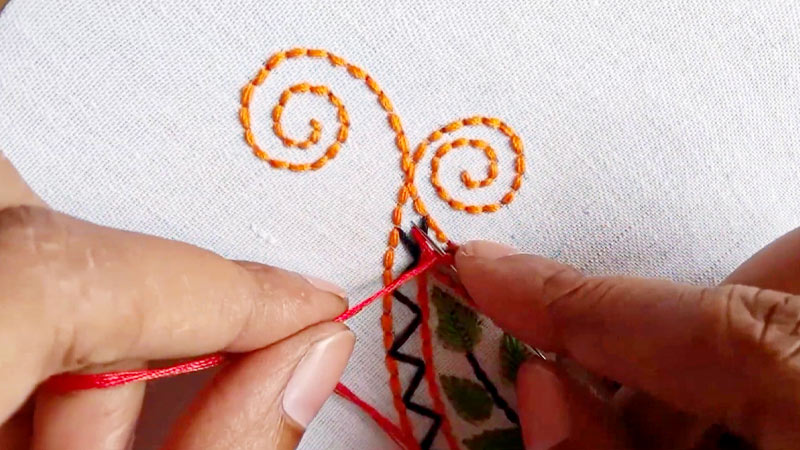Embroidery, a centuries-old craft, weaves intricate tales on fabric through the artful placement of motifs. A motif in embroidery is a recurrent design element, a building block that forms the visual language of the piece.
From delicate floral patterns to geometric precision, motifs play a pivotal role in crafting a narrative, conveying cultural symbols, or simply adding aesthetic appeal. Each stitch contributes to a larger story, a symphony of creativity guided by the embroiderer’s vision.
This introduction explores the essence of motifs in embroidery, delving into their significance as the heartbeat of an art form that stitches together culture, expression, and timeless craftsmanship.

What Is a Motif in Embroidery?
In embroidery, a motif is a recurring design element or theme that is repeated or varied throughout a fabric. These individual patterns or symbols contribute to the overall aesthetic of the embroidered piece.
Motifs can range from simple geometric shapes to intricate floral patterns, allowing for creative expression and personalization. They play a crucial role in creating visual harmony, serving as focal points, and conveying symbolic meanings.
Embroiderers use various techniques, such as appliqué, cross-stitch, and embroidery stitches, to bring these motifs to life. Essentially, motifs are the building blocks that add depth, meaning, and artistic flair to embroidered designs.
Why Are Motifs Important in Embroidery?
Motifs play a significant role in embroidery for several reasons, contributing to the overall aesthetic appeal and artistic expression of the embroidered piece. Here are some key reasons why motifs are essential in embroidery:
Enhancing Aesthetic Appeal
Motifs add visual interest and beauty to embroidery designs. They allow embroiderers to create intricate and decorative patterns, making the fabric visually appealing and captivating.
Creating Harmony and Unity
By repeating motifs throughout a design, embroiderers can create a sense of harmony and unity. This repetition ties the elements together, giving the embroidery a cohesive and polished look.
Adding Variety and Contrast
Motifs provide a means to introduce variety and contrast into the embroidery. Different motifs, whether in shape, size, or complexity, can break up monotony and create a dynamic and visually stimulating composition.
Serving as Focal Points
Well-placed motifs can act as focal points within the embroidery, drawing attention to specific areas of the design. This helps in guiding the viewer’s gaze and emphasizing key elements.
Expressing Meaning and Symbolism
Many motifs carry symbolic meanings. Embroiderers can use motifs to convey messages, express cultural identity, or evoke specific emotions. For example, floral motifs may symbolize growth and beauty, while animal motifs could represent strength or freedom.
Personalization

Motifs offer a way for individuals to personalize their embroidery projects. By selecting motifs that hold personal significance or relevance to their culture, embroiderers can infuse their work with a unique and meaningful touch.
Storytelling and Narrative
Motifs can be used to tell a story or convey a narrative within the embroidery. By strategically placing motifs, embroiderers can create a visual story that engages the viewer and adds depth to the overall design.
Cultural and Historical Significance
Specific motifs carry cultural or historical significance. Incorporating these motifs into embroidery allows for the preservation and celebration of cultural heritage through art.
Craftsmanship and Artistry
The use of motifs showcases the skill and artistry of the embroiderer. Creating intricate and well-executed motifs requires a high level of craftsmanship, contributing to the overall quality and value of the embroidered piece.
Versatility in Design
Motifs can be adapted and applied to various embroidery techniques, allowing for versatility in design. Whether using techniques like appliqué, cross stitch, or embroidery stitches, motifs offer endless possibilities for creative expression.
What Types of Motifs Are Commonly Used in Embroidery?

Embroidery encompasses a wide range of motifs, allowing for diverse and creative expression. Common types of motifs in embroidery include:
Floral Motifs
Flowers and plants are widely used in embroidery. They can represent nature, beauty, growth, and various symbolic meanings. Roses, daisies, and vines are popular choices.
Animal Motifs
Animals and birds are frequently depicted in embroidery, symbolizing characteristics such as strength, freedom, wisdom, and personality. Common choices include butterflies, birds, elephants, and domestic pets.
Geometric Motifs
Geometric shapes and patterns are versatile motifs in embroidery. They can convey a sense of order, balance, symmetry, and harmony. Examples include circles, squares, triangles, and intricate geometric designs.
Abstract Motifs
Abstract motifs allow for more interpretative and artistic expression. These can be non-representational shapes, lines, and patterns that don’t necessarily resemble specific objects but contribute to the overall design aesthetic.
Symbolic Motifs
Symbols with cultural, religious, or personal significance are common in embroidery. These motifs may include religious symbols, icons, or emblems that convey specific meanings relevant to the embroiderer or their culture.
Figurative Motifs
Human figures or representations of people can be used as motifs in embroidery. These may range from simple silhouettes to more detailed depictions, adding a symbolic element to the design.
Celestial Motifs
Stars, moons, and celestial bodies are popular motifs, often symbolizing light, hope, dreams, and spirituality. These motifs can add a celestial or cosmic touch to the embroidery.
Lettering and Words
Embroidered words, phrases, or letters are used to convey messages, quotes, or personal sentiments. Script or block lettering can be incorporated into the design for a customized touch.
Seasonal Motifs
Motifs related to seasons, such as snowflakes for winter or flowers for spring, are commonly used. These motifs can add a thematic element to the embroidery.
Art Deco and Vintage Motifs
Designs inspired by the Art Deco era or vintage styles often feature motifs with intricate patterns, symmetry, and bold geometric shapes, bringing a sense of historical or retro aesthetics to the embroidery.
Botanical Motifs
Beyond simple flowers, specific botanical motifs like leaves, branches, and herbs are popular. These motifs can be used for decorative borders or as standalone elements.
Scenic Motifs
Landscapes, scenes, or depictions of nature can be embroidered to create visually captivating and narrative-rich pieces.
How Do Motifs Contribute to the Overall Design in Embroidery?

Motifs play a crucial role in contributing to the overall design of embroidery, influencing the aesthetic, thematic, and visual aspects of the finished piece.
Here’s how motifs contribute to the overall design:
Harmony and Unity
Motifs help create a sense of harmony and unity in an embroidered piece. By repeating specific motifs throughout the design, embroiderers establish a visual connection between different elements, giving the work a cohesive and polished appearance.
Visual Interest and Appeal
Motifs add visual interest and appeal to the embroidery. Whether they are intricate floral patterns, geometric shapes, or symbolic elements, motifs catch the viewer’s eye and make the design more captivating.
Focal Points
Well-placed motifs can serve as focal points within the embroidery. By strategically positioning certain motifs, embroiderers can draw attention to specific areas of the design, guiding the viewer’s gaze and creating emphasis.
Variety and Contrast
Motifs introduce variety and contrast to the embroidery. Different motifs, whether in shape, size, or complexity, break up monotony and contribute to a dynamic and visually stimulating composition.
Thematic Expression
Motifs help express themes, messages, or narratives within the embroidery. For example, floral motifs may convey a theme of nature and beauty, while animal motifs can represent strength or freedom.
Symbolic Meaning
Many motifs carry symbolic meanings. The incorporation of these symbols allows embroiderers to convey specific messages or sentiments, adding depth and significance to the overall design.
Personalization
Motifs offer a way for individuals to personalize their embroidery projects. By selecting motifs with personal significance or cultural relevance, embroiderers infuse their work with a unique and meaningful touch.
Storytelling and Narrative
Motifs can be used to tell a story or convey a narrative within the embroidery. By arranging motifs in a deliberate sequence, embroiderers can create visual storytelling that engages the viewer on a deeper level.
Cultural Significance
Specific motifs carry cultural or historical significance. Incorporating these motifs into embroidery allows for the celebration of cultural heritage and the preservation of traditional artistic elements.
Craftsmanship and Detail
Motifs showcase the skill and craftsmanship of the embroiderer. Creating intricate and well-executed motifs requires attention to detail, adding to the overall quality and value of the embroidered piece.
Versatility in Design
Motifs can be adapted and applied to various embroidery techniques, allowing for versatility in design. Different stitching methods and styles can be employed to bring motifs to life, offering endless creative possibilities.
What Techniques Are Used to Create Motifs in Embroidery?

Several embroidery techniques can be employed to create motifs, each offering a unique approach to achieving different visual effects.
Here are some standard techniques used to create motifs in embroidery:
Appliqué
Appliqué involves attaching fabric pieces onto a base fabric, creating dynamic and contrasting motifs. This technique allows for vibrant designs with varied textures achieved through stitching or adhesive.
Cross Stitch
Cross stitch, with its tiny x-shaped stitches on a grid-like fabric, is ideal for intricate and textured motifs. Its classic style adds depth and richness to both figurative and geometric designs.
Embroidery Stitch
Various embroidery stitches, such as satin, chain, and stem stitches, offer flexibility in creating motifs. From filling areas to adding details, these stitches contribute to unique textures and aesthetics.
Needlepoint
Needlepoint on a stiff canvas with wool or cotton yarn is suitable for detailed and textured motifs. It allows for a broad range of colors and intricate patterns, providing versatility in design.
Quilting
Quilting, stitching layers of fabric, adds both visual and tactile elements to motifs. Geometric or thematic, quilted motifs enhance the overall design’s appeal.
Crewel Embroidery
Crewel embroidery, using wool yarn on linen, creates detailed and textured motifs. Often featuring florals, it adds a touch of timeless charm to designs.
Stumpwork
Stumpwork, a 3D technique with padded shapes, makes motifs stand out. This adds a sculptural and intricate dimension to the overall embroidery.
Free-motion Embroidery
Free-motion embroidery, with its spontaneous stitching, is perfect for creating organic and unique motifs. It brings a sense of freedom and individuality to the design.
Beadwork Embroidery
Beadwork embroidery involves stitching beads onto fabric, adding sparkle, dimension, and tactile quality to motifs. It creates visually dynamic and appealing effects within the embroidery.
FAQs
Can motifs be customized or personalized in embroidery?
Yes, motifs can be customized to reflect personal tastes, cultural influences, or specific themes. Embroiderers often add a unique touch to their work by selecting motifs with personal significance.
Can motifs be used in both hand embroidery and machine embroidery?
Yes, motifs can be applied in both hand embroidery and machine embroidery. Hand embroidery allows for meticulous detailing, while machine embroidery offers efficiency and precision in replicating motifs.
Are there trends in embroidery motifs that change over time?
Yes, embroidery motifs, like other artistic elements, experience trends that evolve. Specific motifs may gain popularity due to cultural influences, fashion trends, or shifts in artistic preferences.
Can motifs be combined with other elements in embroidery?
Motifs can be combined with colors, textures, materials, and embellishments to create intricate and visually stunning embroidered pieces. The combination of motifs with other elements adds depth and richness to the overall design.
To Recap
The motif in embroidery is more than a mere embellishment; it is the soul of a stitched masterpiece. Through intricate stitches and deliberate choices, embroiderers create visual poetry that resonates with cultural echoes and personal narratives.
The careful repetition or variation of motifs weaves a tapestry of emotions, symbolism, and aesthetic brilliance. As the final stitch is laid, the motif stands as a testament to the artisan’s skill, passion, and creativity.
In this timeless craft, motifs transcend threads and fabric, becoming a language that speaks volumes about tradition, individuality, and the enduring allure of embroidery as an art form that captures stories one stitch at a time.
Leave a Reply